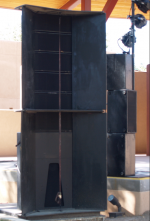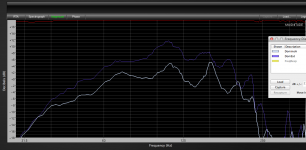Sweet, thanks Art. Pretty close to what I envisioned. I assume the slots and holes make no significant difference in SPL output.
My cabinets are 3/4" baltic birch. Would you recommend I make the waveguide out of baltic birch as well, or do you reckon 3/4" aurauco is sufficient?
And I see you didn't go with the approach of making a square (with the waveguide and mirrored ground plane)...(unless you go two-wide). Still must work well, I imagine.
My cabinets are 3/4" baltic birch. Would you recommend I make the waveguide out of baltic birch as well, or do you reckon 3/4" aurauco is sufficient?
And I see you didn't go with the approach of making a square (with the waveguide and mirrored ground plane)...(unless you go two-wide). Still must work well, I imagine.
Last edited:
Compare the area of the slots and holes to the total mouth area and you could figure the percent reduction in output they cause, ie, something like .001% of 3 dB.Sweet, thanks Art. Pretty close to what I envisioned. I assume the slots and holes make no significant difference in SPL output.
My cabinets are 3/4" baltic birch. Would you recommend I make the waveguide out of baltic birch as well, or do you reckon 3/4" aurauco is sufficient?
And I see you didn't go with the approach of making a square (with the waveguide and mirrored ground plane)...(unless you go two-wide). Still must work well, I imagine.
The handle holes make them much easier to carry, the side pieces in the waveguides in post #40 are just a bit too deep to fit under most people's arms without.
With the handle holes one person can easily carry the four waveguide pieces.
I use 3/4" Arauco ply. Baltic Birch would be stiffer and heavier, but the pressures are not very high with such a large mouth area. I don't notice much vibration even when using the Keystone 18" with 14 eight inch speakers running above sharing waveguides.
The taller the mirrored ground plane image, the less vertical dispersion.
I prefer the audience get the LF sound rather than the birds or the ceiling
Attachments
Last edited:
From a low frequency standpoint, where 1/4 wavelength is the width of the array orgreater, little difference.I wonder if there would be any major difference putting two stacks of subs next to each other and putting the waveguides on the outside of the coupled stack VS two separate stacks with their own waveguide, but next to/touching one another.
At the upper end of the spectrum, say 100 Hz, unless the center to center distance is under a 2.825 feet (less than a meter) or so, there will be off axis comb filtering.
My preference would be tight packing the subs and putting the waveguides outside.
My main PA uses rather small horn top cabinets, only 26.5 inch wide. The horn does not do much below 200 Hz, but a lot of cones makes the response OK to around 70 Hz.
When I need a bit more low end and directivity I use wave-guides in front of the stack, it gives the low end of the horn a 3 dB boost down to around 70 Hz, and maintains the 90 degree pattern down pretty low.
Using bass reflex cabinets or standard horn cabinets below 70 Hz, the wave-guides did not show any level increase in that range.
However, in front of the Keystone TH cabinet, the wave-guide averages more than a 3 dB increase in level over the entire sub range.
The wave-guide/extender significantly increases directivity too.
The wave-guides are four pieces, break down to a package about 6 x 20 x 54.75. Ratchet straps are used to attach the wave-guide to the cabinet, no rattles with full power.
The wave-guides do take a few minutes to set up, but considering the cost to output level increase they afford in a small space, the equivalent of doubling the speaker cabinet without paying for a second speaker, quite worth it on gigs that need a lot of level with the minimum power.
Some construction details have been added in post #40.
Art
Do you think that an extender would lower the F3 of a tapped horn or BLH?
Here's my train of thought:
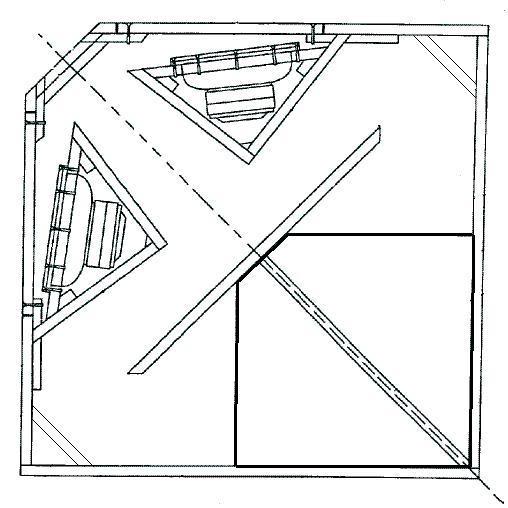
1) It *seems* that extending the horn mouth would lower the F3 by lowering the impedance peaks. Similar to the SPL BDEAP, pictured above
2) Last night I did some experiments with this, with both a tapped horn and a FLH
3) I'd expected to see the impedance peaks go lower, but they didn't. I *did* see a 'flattening' of the peaks, which would generally be correlated with smoother frequency response. (Since a lowering of impedance will 'flatten out' the dips between the peaks, by drawing more power from the amp.)
I still need to experiment with this more, but would love to get some opinions before I go make sawdust.
Patrick,Do you think that an extender would lower the F3 of a tapped horn or BLH?
Turns out my previous statement:
"Using bass reflex cabinets or standard horn cabinets below 70 Hz, the wave-guides did not show any level increase in that range."
was incorrect, as I found out later with more accurate testing.
In all cases, an increased frontal area increased level, but in no case did the F3 go lower than the original response.
Even with the Domino DFLH (pictured in post #40), which IIRC Hornresp indicated would go lower with the extender, it did not, to my dismay
Smoothed the response and added almost 6 dB of "punch" though, as you can see in the chart below.
Attachments
Last edited:
Patrick,
Turns out my previous statement:
"Using bass reflex cabinets or standard horn cabinets below 70 Hz, the wave-guides did not show any level increase in that range."
was incorrect, as I found out later with more accurate testing.
In all cases, an increased frontal area increased level, but in no case did the F3 go lower than the original response.
Even with the Domino DFLH, which IIRC Hornresp indicated would go lower with the extender, it did not, to my dismay.
Smoothed the response and added almost 6 dB of "punch" though.
I didn't have the time or wood to test with a seriously huge baffle; I used one that was 4'x4'. But if my baffle *was* extending the horn mouth, I'd expect to see the impedance troughs go down by at least a few hertz, corresponding with a longer horn path.
I *didn't* see that, which is consistent with your findings.
But smoothing and increasing output levels is a win-win; I'm pretty tempted to try a tapped horn using a BDEAP style layout. (This would also be very home-theater friendly, as we have at least four corners to leverage.)
I posted this over on the Singlesheet Challenge thread but seems relavent here...
Our 2 x SS15 TH`s use extenders ( barn doors) which clamp to the two boxes ... They work very well as the plots from REW below show.. smoothing out the rsponse and extending the low corner a few hz.
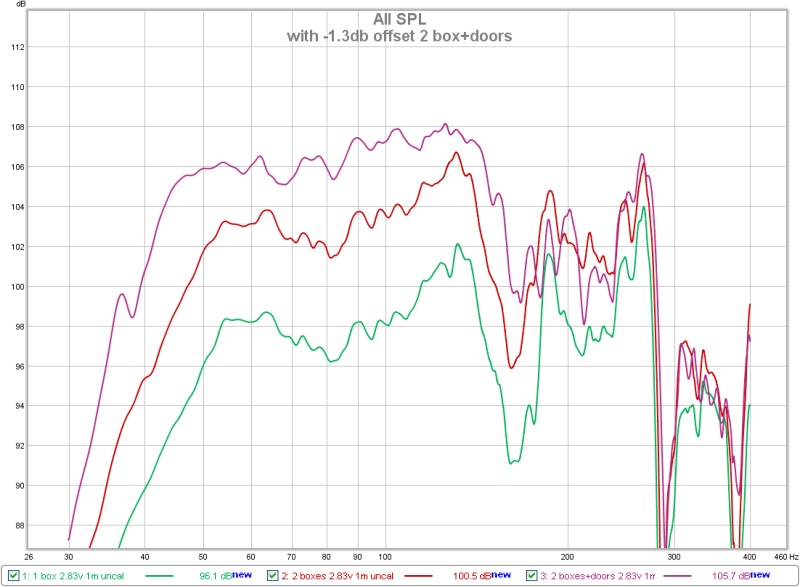
And here`s how it all bolts together...
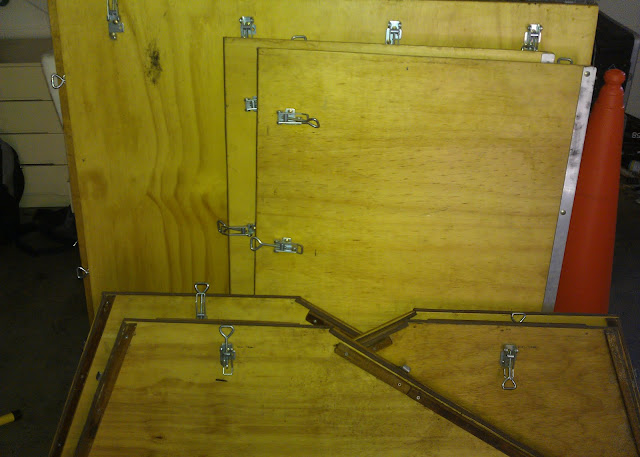
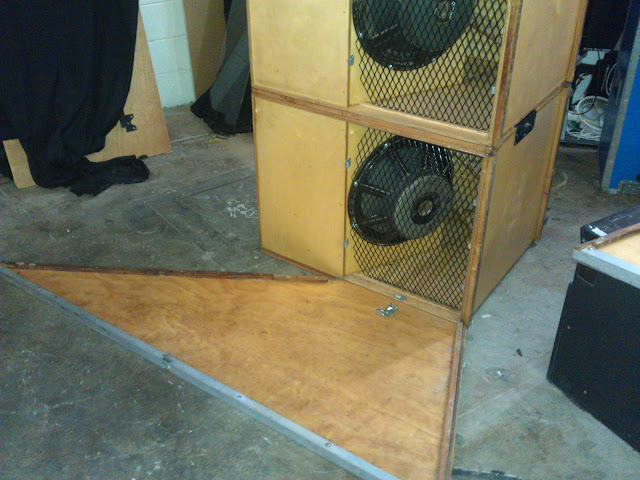
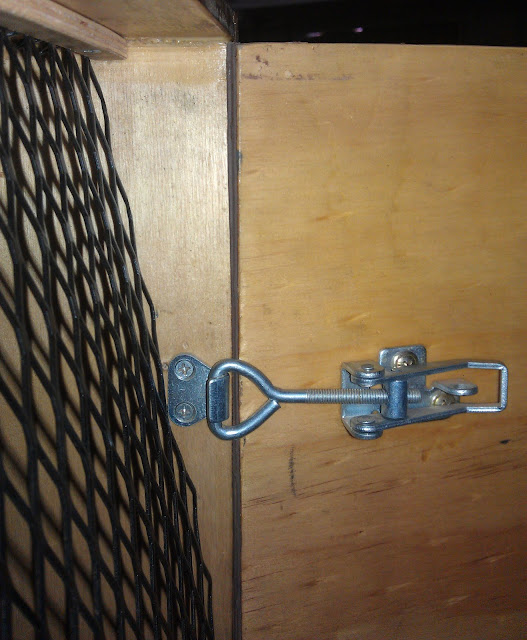
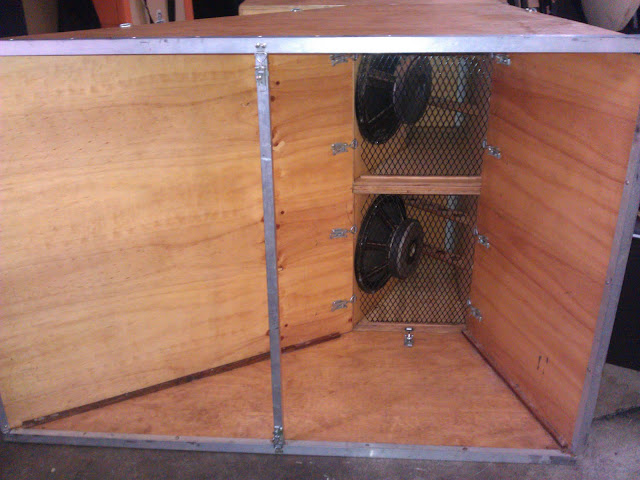
Only thing that needs changing is some additional stringers ( braces) across the flat top panels , they do vibrate on some resonant freqs! Good to watch peoples drinks upend and the standing waves of beer dance about though ....
.p.
Our 2 x SS15 TH`s use extenders ( barn doors) which clamp to the two boxes ... They work very well as the plots from REW below show.. smoothing out the rsponse and extending the low corner a few hz.

And here`s how it all bolts together...




Only thing that needs changing is some additional stringers ( braces) across the flat top panels , they do vibrate on some resonant freqs! Good to watch peoples drinks upend and the standing waves of beer dance about though ....
.p.
Phil,I posted this over on the Singlesheet Challenge thread but seems relavent here...
Our 2 x SS15 TH`s use extenders ( barn doors) which clamp to the two boxes ... They work very well as the plots from REW below show.. smoothing out the rsponse and extending the low corner a few hz.
Excellent results, looks like almost 10 Hz lower response.
Did you experiment with the extender over the whole cabinet face compared to just the mouth exit?
Art
Hi Art
I think I answered this earlier...we took some rough measurements with Holm Impulse which include having an extender from the box edge rather than the horn mouth. They are pretty inconclusive as we weren`t getting reliable data from Holm at that time ( still haven`t worked out why yet!) and not worth posting up. A gut feeling though is that to properly extend a horn you should be following the horn path itself and extending past S5 / S6 / S7 etc etc. I can see that a boundary waveguide will work but nowhere as efficient as an extended horn mouth??
Djlivex...no plans afraid...but I`m sure you can easily work out what`s going on if from memory I think the width of the extended horn mouth is 1200mm ??
Had the system outside for a corporate gig in the city centre today. Compliments all round and lots of questions about " what exactly is that lot!"
Makes it all worthwhile.
.p.
I think I answered this earlier...we took some rough measurements with Holm Impulse which include having an extender from the box edge rather than the horn mouth. They are pretty inconclusive as we weren`t getting reliable data from Holm at that time ( still haven`t worked out why yet!) and not worth posting up. A gut feeling though is that to properly extend a horn you should be following the horn path itself and extending past S5 / S6 / S7 etc etc. I can see that a boundary waveguide will work but nowhere as efficient as an extended horn mouth??
Djlivex...no plans afraid...but I`m sure you can easily work out what`s going on if from memory I think the width of the extended horn mouth is 1200mm ??
Had the system outside for a corporate gig in the city centre today. Compliments all round and lots of questions about " what exactly is that lot!"
Makes it all worthwhile.
.p.
Coolest thread ever... 
Are there more people using a horn extension?
And does anyone know of a brand that is using horn extensions to date... The only one I can think of is Funktion One with the infrahorn (horn extension for two infrabass subs):

This thing is heaviliy braced, instead of some examples in this thread.
I think the mounting is done by ratchet straps.
Anyway, I think the concept has a lot of potential.
Teun
Are there more people using a horn extension?
And does anyone know of a brand that is using horn extensions to date... The only one I can think of is Funktion One with the infrahorn (horn extension for two infrabass subs):

This thing is heaviliy braced, instead of some examples in this thread.
I think the mounting is done by ratchet straps.
Anyway, I think the concept has a lot of potential.
Teun
Last edited:
Bump....
So, I started to look into baffle panels and horn extensions based on Art's comments here:
http://www.diyaudio.com/forums/subwoofers/242321-dual-opposed-slot-loaded-port-3.html#post3859935
This would be to strap onto a vertically stacked pair of B&C loaded 15" BR subs tuned to 35hz.
At the very least, I can come up with some baffle panels using some scrap wood I have around. According to Art's testing, this should improve coupling and add a few db's....
http://www.diyaudio.com/forums/subwoofers/204472-multiple-cabinet-combined-response.html
However, I also went off and ran some horn resp sims with a horn extension (similar in size to the funktion-one unit), by modeling it as a compound horn - on one side the horn on a baffle, other the port tube, then baffle then horn. To my suprise this seemed to work. I got around 3-5 db and flat response with a 4 m^2 horn mouth and 1m depth. This is huge though. Going a bit smaller seems to be ok. I'll post the model tonight if I can, if there's any interest. Not sure if it's something I can build and have be transportable.
So, I started to look into baffle panels and horn extensions based on Art's comments here:
http://www.diyaudio.com/forums/subwoofers/242321-dual-opposed-slot-loaded-port-3.html#post3859935
This would be to strap onto a vertically stacked pair of B&C loaded 15" BR subs tuned to 35hz.
At the very least, I can come up with some baffle panels using some scrap wood I have around. According to Art's testing, this should improve coupling and add a few db's....
http://www.diyaudio.com/forums/subwoofers/204472-multiple-cabinet-combined-response.html
However, I also went off and ran some horn resp sims with a horn extension (similar in size to the funktion-one unit), by modeling it as a compound horn - on one side the horn on a baffle, other the port tube, then baffle then horn. To my suprise this seemed to work. I got around 3-5 db and flat response with a 4 m^2 horn mouth and 1m depth. This is huge though. Going a bit smaller seems to be ok. I'll post the model tonight if I can, if there's any interest. Not sure if it's something I can build and have be transportable.
800 pound speakers - Community Leviathan II - Page 3
The parts nestled inside of each other so you could transport a good sized ststem in a van.
The parts nestled inside of each other so you could transport a good sized ststem in a van.
Last edited:
Bump. Bought wood last night to do this.
Currently have two front slot ported 15's tuned to 35hz, 4 cubes gross, box dims 20" H x 16" W x 22". Will stack the subs, with the lower sub upside down so the ports are in the middle of the stack.
Ran multiple models in hornresp, as a dual driver compound horn (horn on both sides of driver), with driver right on the horn on one side and the cabinet internal plus port plus step up in size on the other. A pic would be helpful here but I don't have it handy. Ends up with a 1-2 db boost at 35 hz, 6 db boost at 100hz that will have to eq out.
It will be similar in idea to Art's extensions. The stack will have a frontal area of 40" H x 16", on to which a 24" deep horn with a 64" W x 40" mouth will be attached. 3/4" high quality sheathing plywood, lagged together, braces lagged on, can be dissassembled and is hinged to fold up. Wanted to go bigger, but this is about as big as I could go on one sheet of plywood, and I figured I'd be better off with 3/4" vs. thinner.
Hopefully it should give at least a solid 3 db gain due to better coupling plus 1-2 db from the mild horn effect, and maybe a bit from mimiced corner loading? Who knows....I will definitely be taking somevery basic db measurements to see what it's doing. More to come!
Currently have two front slot ported 15's tuned to 35hz, 4 cubes gross, box dims 20" H x 16" W x 22". Will stack the subs, with the lower sub upside down so the ports are in the middle of the stack.
Ran multiple models in hornresp, as a dual driver compound horn (horn on both sides of driver), with driver right on the horn on one side and the cabinet internal plus port plus step up in size on the other. A pic would be helpful here but I don't have it handy. Ends up with a 1-2 db boost at 35 hz, 6 db boost at 100hz that will have to eq out.
It will be similar in idea to Art's extensions. The stack will have a frontal area of 40" H x 16", on to which a 24" deep horn with a 64" W x 40" mouth will be attached. 3/4" high quality sheathing plywood, lagged together, braces lagged on, can be dissassembled and is hinged to fold up. Wanted to go bigger, but this is about as big as I could go on one sheet of plywood, and I figured I'd be better off with 3/4" vs. thinner.
Hopefully it should give at least a solid 3 db gain due to better coupling plus 1-2 db from the mild horn effect, and maybe a bit from mimiced corner loading? Who knows....I will definitely be taking somevery basic db measurements to see what it's doing. More to come!
Did pretty much exactly as described above, except little bit bigger, using most of a whole sheet of ply. Worked really well, got very strong kick due to the horn action that was EQ'd out a bit, and cut out a bit by using a 2nd order low pass on the subs. Seemed to be VERY effective outside. Hard to tell for sure without doing proper before and after measurements which I did not have time for, but it seemed there was strong low bass and the coupling effect that Art tested was occurring.
Hi Art,
More questions:
Since you've suggested extending twice as wide as the enclosure is tall, to end up w/a square mouth after accounting for the mirrored ground plane -OR- to extend taller to increase horizontal coverage, etc. -- what dimensions would you recommend starting with for those stacking 4 Keystones THs or 4 Xoc1 TH-18s, 2x2, on their side, bottoms touching?
Either of those two designs are nearly a 2:1 (W:H) in this configuration (Keystone: 90" x 53" & TH-18: 80" x 45"), equalling a near square shape when including the ground plane mirror. As a center stack, a waveguide extending much higher vertically would block the performer(s) (unless a good sized stage/riser is used) and extending horizontally may increase (often times unwanted) vertical coverage and end up being quite the wide stack. With that much frontal area already, do you see a waveguide/extender still being very beneficial?
Cheers for all your input!
More questions:
Since you've suggested extending twice as wide as the enclosure is tall, to end up w/a square mouth after accounting for the mirrored ground plane -OR- to extend taller to increase horizontal coverage, etc. -- what dimensions would you recommend starting with for those stacking 4 Keystones THs or 4 Xoc1 TH-18s, 2x2, on their side, bottoms touching?
Either of those two designs are nearly a 2:1 (W:H) in this configuration (Keystone: 90" x 53" & TH-18: 80" x 45"), equalling a near square shape when including the ground plane mirror. As a center stack, a waveguide extending much higher vertically would block the performer(s) (unless a good sized stage/riser is used) and extending horizontally may increase (often times unwanted) vertical coverage and end up being quite the wide stack. With that much frontal area already, do you see a waveguide/extender still being very beneficial?
Cheers for all your input!
1) The bigger the better, though after an initial doubling of frontal area, the next doubling requires a lot more plywood.1) what dimensions would you recommend starting with for those stacking 4 Keystones THs or 4 Xoc1 TH-18s, 2x2, on their side, bottoms touching?
2) With that much frontal area already, do you see a waveguide/extender still being very beneficial?
2) +3 dB (or more with larger waveguides) increase in forward level with no power compression is very beneficial, whether it is worth the work/benefit/cost ratio depends on many factors.
- Home
- Loudspeakers
- Subwoofers
- Horn Extender/Wave-guide for TH
